Here are some common musical terms for guitarists. Understanding these terms will help as you learn how to play guitar.
- Accent
- Special stress given to a musical note within a phrase.
- Adagio
- Indication that the music should be played at a speed not as slow as larghetto. 66 – 75 ticks per minute.
- Allegro
- Lively, or happy. Often used to indicate a fast piece, but not as fast as presto. 120 – 167 ticks per minute.
- Andante
- Indication of tempo (at a walking pace). 76 – 107 ticks per minute.
- Bend
- A guitar technique popular in blues and rock where the string is “bent” by pushing it across the fret (parallel to it) with your finger.
- Bridge
- The section on the body of the guitar where the strings are attached.
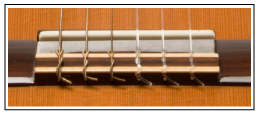
The bridge of a classical guitar. 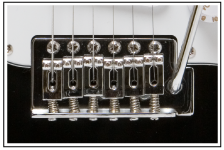
An electric guitar tremolo bridge. - Capo
- A device that acts like a barre going across a fret. It is used so that you can play open guitar chords in different keys.
- Chika
- The sound of a muted chord.
- Chord
- A combination of three or more tones sounded simultaneously.
- Chord chart
- Sometimes called a chord diagram, this is the standard notation used to represent chord fingerings on the fretboard of a guitar. Below is an example of a chord chart. Chord chart can also describe a piece of guitar music that shows the chord progression for a song.
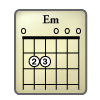
- Classical guitar
- A nylon string guitar used for playing classical music.
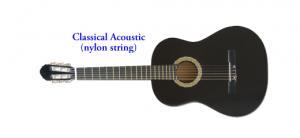
- Electric guitar
- Electric guitars have a way to sense guitar string (and sometimes body) vibrations and send them to an amplifier to be made louder. They use a truss rod in the neck as they have steel strings and usually have lighter gauge strings than acoustic guitars.
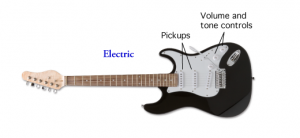
- Fingerboard (Fretboard)
- On guitars this is also called the fretboard, as guitar fingerboards are demarcated with frets (definition below). This is the flat, front section on the neck that your fingers will play.
- Frets
- The thin strips of metal placed across the neck of the guitar at regular intervals to shorten/lengthen the string and create different notes. Fingers press down behind the frets to select the notes.
- Gauge
- The term used to describe a wire’s diameter, and in music to describe the thickness of an instrument string. String gauges are measured in thousandths of an inch. For example, the high E string used on many electric guitars is .009 gauge, or “9 thousandths of an inch”.
- Half step
- The smallest interval (see Interval below).
- Head (Headstock)
- Section of the guitar located on top of the neck and on which the tuning keys are mounted.
- Interval
- An interval is the distance between two pitches. In western music this is expressed numerically based on their distance from one another in a diatonic scale. For example, from the first note of the major scale to the third note the interval would be expressed as a major third as it is the third note of the scale. The smallest interval step is the semitone (or half step), which is the interval between two adjacent note in a chromatic scale. A whole tone (or whole step) is comprised of two semitones.
- Larghetto
- Indication that the music should be played at a tempo not quite so slow as largo. 60 – 65 ticks per minute.
- Largo
- Indication that the music should be played slowly, in a broad manner. 40 – 59 ticks per minute.
- Major Chord
- A chord with three notes called a triad (see definition below), that combines the first, third, and fifth notes of a major scale. Major chords have a happy or cheerful sound.
- Measures
- Sections of music organized with a certain number of beats determined by the time signature. For example, one measure in 4/4 time might be made up of four quarter (1/4) notes, or 8 eighth (1/8th) notes.
- Melody
- A rhythmically organized sequence of single tones so related to one another as to make up a particular musical phrase or idea.
- Metronome
- A device that marks time at a steady beat in adjustable intervals, to help keep a steady beat while playing music.
- Minor chord
- A chord with three notes called a triad (see definition below), that combines the first, flatted third, and fifth notes of a major scale. Minor chords have a darker, melancholy sound.
- Moderato
- Moderate, as in a moderate speed. 108 – 119 ticks per minute.
- Muting
- Touching played strings lightly to deaden their sound.
- Neck
- Section of the guitar that includes the fretboard and carries the strings from the body to the head of the guitar.
- Note
- A single sound, or its representation in music notation.
- Nut
- Raised bar at the top of the fretboard that supports the strings and stops their vibration, as they run to the head of the guitar.
- Open string
- A string that is sounded without being held down with the left hand.
- Palm muting
- A technique in which the palm of the right hand is laid on the strings just above the bridge, so that the strings are slightly muffled; this is different from muting, where the strings are deadened.
- Pick guard
- A plate located on the body of the guitar to protect it from getting scraped by the pick.
- Pickups
- Electrical apparatus on the body of electric guitars which converts sound into electrical signals.
- Pitch
- A distinct musical note.
- Power chords
- Chords that use only the two lowest strings of a normal chord; indicated by the symbol “5” (e.g. “A5” for an A power chord). The chords are created using the first and fifth steps of a major or minor scale.
- Prestissimo
- Very fast indeed. Faster than presto. 181 – 208 ticks per minute.
- Presto
- Fast. Indication that the music be played at a fast tempo. 168 – 180 ticks per minute.
- Reference notes
- Properly tuned notes used to tune another instrument by comparison.
- Rhythm
- A regular pattern formed by a series of notes of differing duration and stress.
- Riff
- A short musical phrase that a song is based on.
- Root
- The note from which a chord is built. For example, the root of the A minor chord is the A note.
- Sound hole
- An opening cut into the body of the guitar to allow sound to project.
- Steel-string acoustic
- An acoustic guitar that uses steel strings vs. nylon (such as classical guitars). These guitars usually have a truss bar in the neck to handle the extra tension of steel strings and use bridge pins to terminate the string at the bridge.
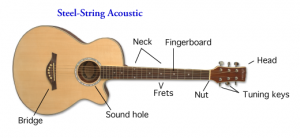
- Syncopation
- Stressing a beat which is normally weak.
- Guitar Tabs or Tablature
- A system of notation using letters, numbers and symbols to indicate finger placement and notes sequences for playing a musical piece on a specific instrument (guitar, bass, etc.).
- Tempo
- Rate of speed at which music is played, usually expressed in beats per minute (BPM).
- Tie
- A curved line connecting two identically-pitched notes, implying that only the first note is to be plucked, and the note is sustained for the entire duration of the two notes combined.
- Tone controls
- Knob(s) located on the body of an electric guitar which allow the player to adjust the characteristics of the sound.
- Tuning keys
- Used to tune the strings of the guitar. The strings are wound around six pegs located on the head of the guitar. The pegs are turned to make the strings tighter or looser, according to the desired pitch.
- Triad
- A chord made of three notes usually spaced as every other note in a scale.
- Truss bar
- This is a steel bar that runs through the neck of guitars that use steel strings. It reinforces the guitar neck to handle the extra tension of steel strings.
- Volume controls
- Knob(s) located on the body of an electric guitar which allow the player to adjust the volume of the guitar.